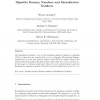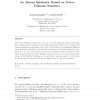721 search results - page 3 / 145 » Bounds on the k-domination number of a graph |
COMBINATORICA
1998
13 years 5 months ago
1998
We prove that the total chromatic number of any graph with maximum degree is at most plus an absolute constant. In particular, we show that for su ciently large, the total chromat...
MP
2010
13 years 3 months ago
2010
The Lov´asz theta number of a graph G can be viewed as a semidefinite programming relaxation of the stability number of G. It has recently been shown that a copositive strengthe...
GD
2005
Springer
13 years 10 months ago
2005
Springer
Let S be a set of horizontal line segments, or bars, in the plane. We say that G is a bar visibility graph, and S its bar visibility representation, if there exists a one-to-one co...
DM
2000
13 years 5 months ago
2000
The Zarankiewicz number z(s, m) is the maximum number of edges in a subgraph of K(s, s) that does not contain K(m, m) as a subgraph. The bipartite Ramsey number b(m, n) is the lea...
JCT
2010
13 years 3 months ago
2010
The vertex Folkman number F(r, n, m), n < m, is the smallest integer t such that there exists a Km-free graph of order t with the property that every r-coloring of its vertices...




